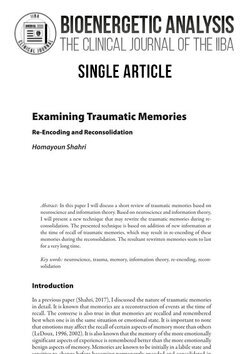18 Seiten, PDF-E-Book
Erschienen: Februar 2018
Bestell-Nr.: 36038
https://doi.org/10.30820/0743-4804-2018-28-45
Homayoun Shahri
Examining Traumatic Memories (PDF)
Re-Encoding and Reconsolidation
Sofortdownload
Dies ist ein E-Book. Unsere E-Books sind mit einem personalisierten Wasserzeichen versehen,
jedoch frei von weiteren technischen Schutzmaßnahmen (»DRM«).
Erfahren Sie hier mehr zu den Datei-Formaten.
In diesem Artikel werde ich – basierend auf Neurowissenschaft und Informationstheorie – in einem kurzen Überblick traumatische Erinnerungen diskutieren, Neurowissenschaften und Informationstheorie folgend werde ich eine neue Technik vorstellen, welche es ermöglicht, traumatische Erinnerungen zu überschreiben. Die vorgestellte Technik basiert darauf, dass neue Information hinzugefügt wird, während traumatische Erinnerungen abgerufen werden. Dies kann dazu führen, dass diese Erinnerungen neu kodiert werden während der Rekonsolidierung.Die so neu geschriebenen Erinnerungen scheinen eine sehr lange Zeit anzuhalten.
Abstract:
In this paper I will discuss a short review of traumatic memories based on neuroscience and information theory. Based on neuroscience and information theory, I will present a new technique that may rewrite the traumatic memories during reconsolidation. The presented technique is based on addition of new information at the time of recall of traumatic memories, which may result in re-encoding of these memories during the reconsolidation. The resultant rewritten memories seem to last for a very long time.
Abstract:
Dans cet article, je propose un bref résumé de ce que sont les mémoires traumatiques à partir de les neurosciences et de la théorie de l’information. Je présente ensuite une nouvelle technique, basée sur les neurosciences et la théorie de l’information, permettant la réécriture des mémoires traumatiques pendant la phase de reconsolidation. Cette technique est basée sur l’ajout de nouvelle information au moment du rappel en mémoire des souvenirs traumatiques, ce qui peut déboucher sur le ré-encodage de ces mémoires pendant la phase de reconsolidation. Les mémoires réécrites semblent stables sur une longue période après ce réencodage.
Abstract:
In questo articolo l’autore prende in esame una breve rassegna di memorie traumatiche in base alle neuroscienze e alla teoria dell’informazione e presenta una nuova tecnica che può riscrivere i ricordi traumatici durante la riconsolidazione. Questa tecnica si basa sull’aggiunta, nel momento del richiamo di memorie traumatiche, di nuove informazioni che possono provocare la loro re-codifica durante la riconsolidazione. Le risultanti risposte ri-scritte sembrano durature.
Abstract:
In this paper I will discuss a short review of traumatic memories based on neuroscience and information theory. Based on neuroscience and information theory, I will present a new technique that may rewrite the traumatic memories during reconsolidation. The presented technique is based on addition of new information at the time of recall of traumatic memories, which may result in re-encoding of these memories during the reconsolidation. The resultant rewritten memories seem to last for a very long time.
Abstract:
Dans cet article, je propose un bref résumé de ce que sont les mémoires traumatiques à partir de les neurosciences et de la théorie de l’information. Je présente ensuite une nouvelle technique, basée sur les neurosciences et la théorie de l’information, permettant la réécriture des mémoires traumatiques pendant la phase de reconsolidation. Cette technique est basée sur l’ajout de nouvelle information au moment du rappel en mémoire des souvenirs traumatiques, ce qui peut déboucher sur le ré-encodage de ces mémoires pendant la phase de reconsolidation. Les mémoires réécrites semblent stables sur une longue période après ce réencodage.
Abstract:
In questo articolo l’autore prende in esame una breve rassegna di memorie traumatiche in base alle neuroscienze e alla teoria dell’informazione e presenta una nuova tecnica che può riscrivere i ricordi traumatici durante la riconsolidazione. Questa tecnica si basa sull’aggiunta, nel momento del richiamo di memorie traumatiche, di nuove informazioni che possono provocare la loro re-codifica durante la riconsolidazione. Le risultanti risposte ri-scritte sembrano durature.
Vincentia Schroeter & Margit Koemeda S. 7–9Letter from the Editor (PDF)
Helen Resneck-SannesS. 11–26Historical and Contemporary Psychoanalytic and Bioenergetic Perspectives of Sexuality (PDF)
Lets Bring it Back into the Therapy RoomArild HafstadS. 27–43The Mysterious Life Energy (PDF)
On the Validity of the Bioenergetic ConceptHomayoun ShahriS. 45–62Examining Traumatic Memories (PDF)
Re-Encoding and ReconsolidationJohn CongerS. 63–74Fleas on the Back of a Wild Dog (PDF)
Five Skulls and Human HistoryAnat GihonS. 75–97Aggression as a Significant Factor in the Formation and Expression of the Self (PDF)
Julia Cegatti & Leticia Polosecki S. 99–118Uses of the Sphere as a Motherfied Object in Bioenergetic Analysis (PDF)
Helen Resneck-SannesS. 11–26Historical and Contemporary Psychoanalytic and Bioenergetic Perspectives of Sexuality (PDF)
Lets Bring it Back into the Therapy RoomArild HafstadS. 27–43The Mysterious Life Energy (PDF)
On the Validity of the Bioenergetic ConceptHomayoun ShahriS. 45–62Examining Traumatic Memories (PDF)
Re-Encoding and ReconsolidationJohn CongerS. 63–74Fleas on the Back of a Wild Dog (PDF)
Five Skulls and Human HistoryAnat GihonS. 75–97Aggression as a Significant Factor in the Formation and Expression of the Self (PDF)
Julia Cegatti & Leticia Polosecki S. 99–118Uses of the Sphere as a Motherfied Object in Bioenergetic Analysis (PDF)

